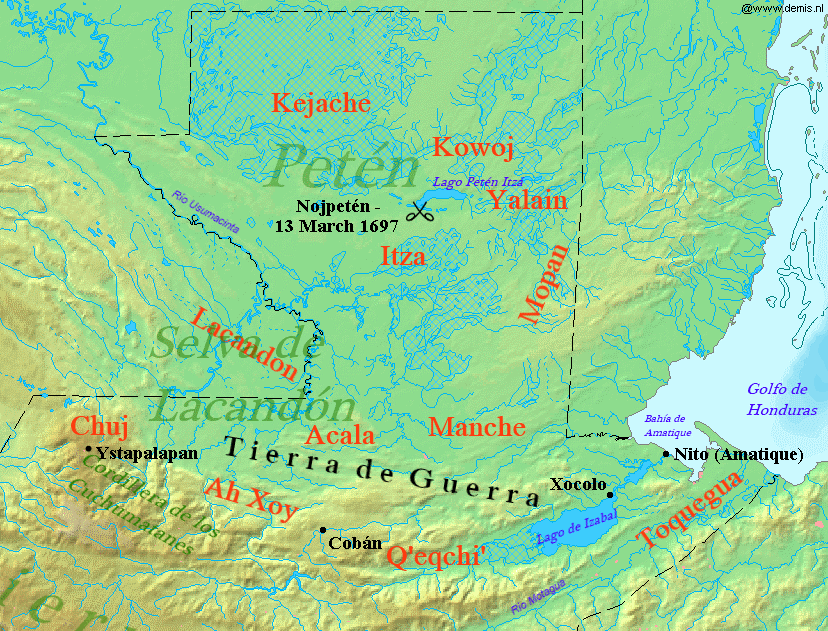Acala Chʼol on:
[Wikipedia]
[Google]
[Amazon]
 The Acala Chʼol were a former Chʼol-speaking
The Acala Chʼol were a former Chʼol-speaking
 The Acala Chʼol were a former Chʼol-speaking
The Acala Chʼol were a former Chʼol-speaking Maya people
Maya () are an ethnolinguistic group of Indigenous peoples of the Americas, Indigenous peoples of Mesoamerica. The ancient Maya civilization was formed by members of this group, and today's Maya are generally descended from people who lived w ...
who occupied a territory to the west of the Manche Chʼol and east of the Chixoy River
The Chixoy River or Río Chixoy is a river in Guatemala. The river is called Río Negro from its sources in the highlands of Huehuetenango and El Quiché until it reaches the Chixoy hydroelectric dam (located at ), where the Río Salamá and Rio ...
in what is now the Alta Verapaz Department
Alta Verapaz () is a department in the north central part of Guatemala. The capital and chief city of the department is Cobán. Verapaz is bordered to the north by El Petén, to the east by Izabal, to the south by Zacapa, El Progreso, an ...
of Guatemala
Guatemala, officially the Republic of Guatemala, is a country in Central America. It is bordered to the north and west by Mexico, to the northeast by Belize, to the east by Honduras, and to the southeast by El Salvador. It is hydrologically b ...
. The Acala should not be confused with the people of the former Maya territory of Acalan, near the Laguna de Terminos in Mexico
Mexico, officially the United Mexican States, is a country in North America. It is the northernmost country in Latin America, and borders the United States to the north, and Guatemala and Belize to the southeast; while having maritime boundar ...
.
By the 17th century the Acala had two principal towns; Cagbalam had 300 multiple-family houses and Culhuacan had over 140. The towns were divided into four sections, each governed by their own ruler. The combined population of these two towns has been estimated at 7,000. The Acala were allies of the Lakandon Chʼol, their immediate neighbours to the west, and the two peoples sometimes cooperated militarily. The Acala are known to have cultivated cacao and achiote
''Bixa orellana'', also known as achiote, is a shrub or small tree native to Central America. ''Bixa orellana'' is grown in many countries worldwide.
The plant is best known as the source of annatto, a natural orange-red condiment (also calle ...
.
In 1555 the Spanish carried out a military expedition against the Acala in retaliation for their killing of Dominican friar Domingo de Vico and his companion Andrés López. The Spanish and their Christianised Qʼeqchiʼ
Qʼeqchiʼ () (Kʼekchiʼ in the former orthography, or simply Kekchi in many English-language contexts, such as in Belize) are a Maya people
Maya () are an ethnolinguistic group of Indigenous peoples of the Americas, Indigenous peoples o ...
Maya allies captured 260 Acalas, and hanged 80 of these; the rest were sold as slaves. Many Acala were rounded up by the Qʼeqchʼi and forcibly moved to settle the San Marcos and San Juan Acala districts of Cobán
Cobán (), fully Santo Domingo de Cobán, is the capital of the department of Alta Verapaz in central Guatemala. It also serves as the administrative center for the surrounding Cobán municipality. It is located 219 km from Guatemala City.
A ...
, capital of colonial Verapaz. Acala from the Chama region were settled in the San Marcos district; the San Juan Acala district received the former inhabitants of the Chisec region. By 1720 the Acala had been completely extinguished, such that there was not even memory of them. Some of the Lakandon and Acala Chʼols fled their forcible resettlement in Cobán and returned to former Acala territory along the course of the Xoy River, where they became known as the Ah Xoy.
Notes
References
* * * * * {{authority control Maya peoples History of Guatemala Former Indigenous peoples in Guatemala Alta Verapaz Department Maya Contact Period Chʼol